PHOENIX - MARS LANDER
LAUNCHED - LANDED
AUGUST 4, 2007 - MAY 26, 2008
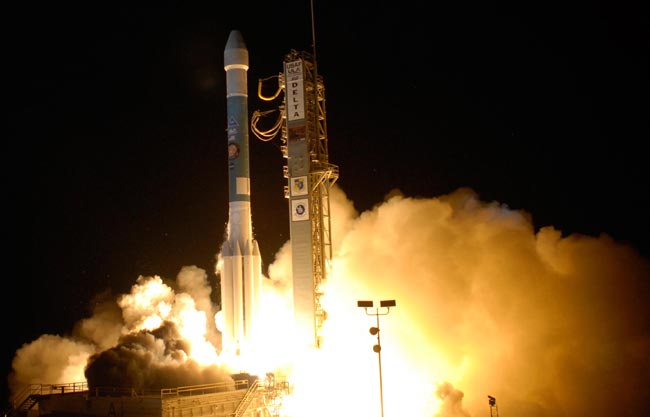
NASA's Phoenix
Mars Lander lifts off from Pad 17A aboard a Delta II 7925 rocket
amid billows of smoke at Cape Canaveral Air Force Station at 5:26 a.m. EDT on
Aug. 4, 2007.
Credit: NASA/Regina Mitchell-Ryall and Jerry Cannon.
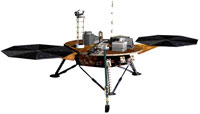
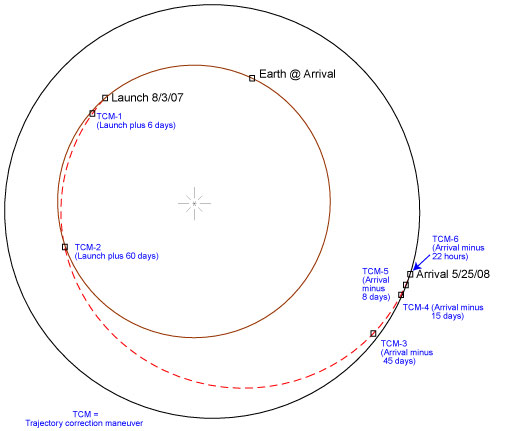
This image details the path of
NASA's Phoenix Mars Lander as it heads to a planned May 25, 2008
landing near the red planet's north pole. Credit: University of Arizona.
MARS IN THE HIVE:
May 23, 2008 -
"Mars has entered the realm of Beehive star cluster," reports
Babak Tafreshi from the
Alborz Mountains of Iran. "The conjunction is a beautiful scene even
with smallest binoculars and modest telescopes.""Mars crosses
the heart of the cluster on Friday, May 23rd," adds Tafreshi. To
find them, look west after sunset for the Red Planet glowing like a
1st magnitude star in the constellation Cancer:
sky map. Scan the area with binoculars and voila!--Mars in the
Hive.
NASA preps for '7 minutes of terror' on Mars
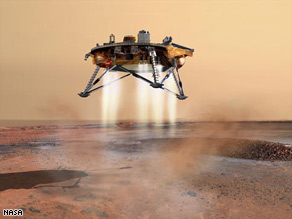
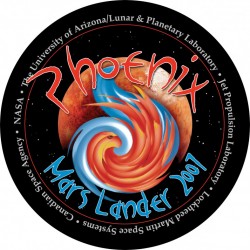
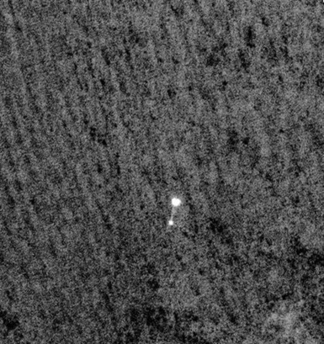
This photo provided by
NASA/JPL-Caltech/University of Arizona shows NASA's Phoenix Mars
Lander suspended from its parachute as it lands on Mars on
Sunday May 25, 2008 as seen by a telescopic camera in orbit.
(AP Photo/NASA/JPL-Caltech/University
of Arizona)
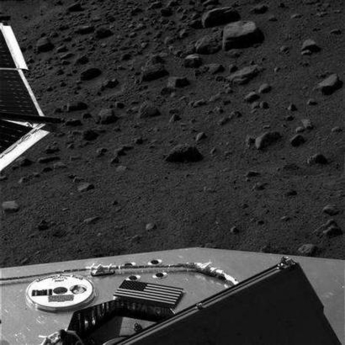
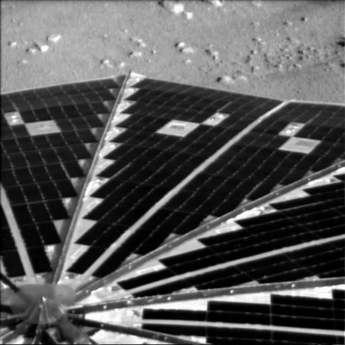
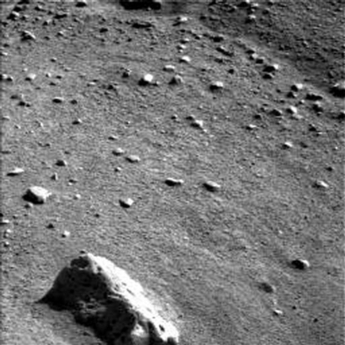
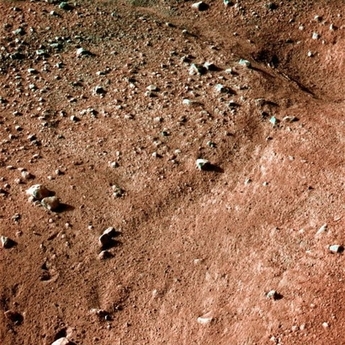
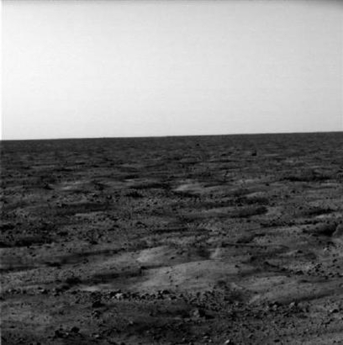
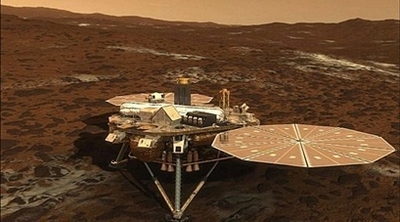
In this artist's
illustration obtained from NASA shows the Phoenix Mars Lander on
the surface of Mars after landing on the planet's surface
(AFP/NASA)
Mars Phoenix Lander team will be biting their
nails Sunday during the landing
It will take just 7 minutes to enter
atmosphere, slam on brakes, and touch down
If the landing is successful, the researchers
will quickly begin science operations
Whether Phoenix will find evidence of life on
Mars is impossible to predict
(CNN)
-- In the wake of the wildly successful Spirit
and Opportunity rover missions, you would think NASA
would approach the landing of the next Martian probe
with high confidence.
But the truth is sometimes
not what you would think.
"I do not feel confident. But
in my heart I'm an optimist, and I think this is
going to be a very successful mission," said
principal investigator Peter Smith, an optical
scientist with the University of Arizona. "The
thrill of victory is so much more exciting than the
agony of defeat."
Indeed, the truth is that the
planetary scientists and engineers who make up the
Mars Phoenix Lander team will be biting their nails
Sunday evening as they cluster around computer
monitors in mission control at the Jet Propulsion
Laboratory in Pasadena, California.
That's when their spacecraft,
which launched to Mars last August, will finally
arrive on the Red Planet.
Everyone on the team is
primed and ready to get down to business, putting
the suite of scientific instruments aboard Phoenix
to work analyzing the soils and permafrost of Mars'
arctic tundra for signatures of life, either past or
present.
But first, they have to get
the lander on the ground, and that's where the worry
comes in. In fact, they have a name for it in the
Mars exploration community -- "seven minutes of
terror."
Seven minutes is all it takes
for a spacecraft travelling neary 13 thousand miles
per hour to hit the Martian atmosphere, slam on the
brakes, and reach the ground.
During that time, onboard
computers will be working at a manic pace as the
spacecraft deploys its parachute, jettisons its heat
shield, extends its three legs, releases the
parachute, and finally fires its thrusters to bring
it down for a soft landing. Hopefully.
"Everything has to go right,"
said
NASA Associate Administrator Ed Weiler. "You
can't afford any failures."
It's risky business.
Historically, 55 percent of all Mars missions have
ended in failure. And tensions will be particularly
high with the Phoenix spacecraft.
From an overall design
standpoint, it is twin to the Mars Polar Lander
spacecraft, and was supposed to travel to Mars in
2001 as the Mars Surveyor spacecraft. They were
originally part of the "better, faster, cheaper"
program, formulated by then-NASA Administrator Dan
Goldin to beef up planetary exploration on a lean
budget.
But disaster struck.
Mars Polar Lander
malfunctioned during its entry and descent into
Mars' atmosphere in 1999 and crashed. Technical
investigations later concluded that as many as a
dozen design flaws or malfunctions doomed the
spacecraft.
The failure of that mission,
as well as another spacecraft called the Mars
Climate Orbiter the same year, led to some soul
searching at NASA. The agency put future missions on
hold to rethink the "better, faster, cheaper"
approach. And Mars Surveyor went to the warehouse.
"The trouble is somebody
forgot the 'better' part," said Weiler. "By pushing
the faster and cheaper part so hard, engineers were
forced to make decisions that weren't necessarily
the best and right decisions. And that led to both
the failures of the Mars Climate Orbiter and
ultimately the Mars Polar Lander and eventually the
entire Mars program."
But all was not lost. In
2003, Peter Smith proposed a plan to reengineer that
mothballed spacecraft and fly it on a mission to
look for signatures of life in the ice and dirt of
Mars far North. Mars Phoenix, literally and
figuratively, rose from the ashes of Surveyor.
Engineers set to work,
testing and re-testing the onboard system to ferret
out and fix all the flaws they could find. But even
the lead engineer admits he worries they might have
missed something.
"We always have to be scared
to death," said project manager Barry Goldstein.
"The minute we lose fear is the minute that we stop
looking for the next problem."
Another aspect of the Phoenix
landing that has the team worried is the landing
system itself. NASA has not successfully landed a
probe on Mars using landing legs and stabilizing
thrusters since the Viking missions in the late
1970's.
The other three successful
Mars landings -- Pathfinder in 1997 and the Spirit
and Opportunity rovers in 2004 - used massive
airbags that inflated around the landing craft just
before landing to cushion the impact.
"I love airbags," said Weiler.
"We got three success stories with airbags, but you
don't invent science by continuing to do what you
know how to do."
Engineers did not use airbags
on Phoenix because the lander is simply too big and
heavy for them to work properly. And NASA will have
to figure out how to land reliably with thrusters
and landing legs in order to fly even larger
spacecraft in the future.
"We landed on Mars with
rockets and legs twice with Viking. It's not
impossible by definition, we have proof of it," said
Weiler. "Humans will have to land on landing legs.
Eventually we want to send humans there, obviously."
Assuming the landing is
successful, the researchers will quickly begin
science operations.
The Phoenix landing site is
targeted for the far Northern plains of the Mars,
near the northern polar ice cap. Data from the Mars
Odyssey spacecraft indicate large quantities of ice
in the area, likely in the form of permafrost,
either on the surface or just barely underground.
Phoenix is equipped with a
robotic arm that can dig down and scoop up some of
that ice and dirt, to look for organic chemical
evidence that life once existed there, or even still
exists now.
"We are not going to be able
to answer the final question of 'is there life on
Mars,' " said Smith. "We will take the next
important step. We'll find out if there's organic
material associated with this ice in the polar
regions. Ice is a preserver and if there ever were
organics on Mars and they got into that ice they
will still be there today."
Indeed, "follow the water"
has become the unifying theme of NASA's Mars
exploration strategy.
In 2004, the rover
Opportunity found evidence that a salty sea once
lapped the shores of an area near Mars' equator
called Meridiani Planum. Astrobiologists, scientists
who study life on other planets, generally agree
that wet places are the best places to look for
life.
"There is no life on earth
where there isn't water," said Weiler. "However
where there's water you find life especially if you
have organics, organic material and energy."
Whether or not Phoenix will
find smoking gun evidence of life on Mars is
impossible to predict. But Peter Smith thinks
success is within reach.
"Well my gut tells me that
life is common in the universe and probably
somewhere on Mars there is organic material and
perhaps even living material.
"Whether it's in the northern
plains I have no idea. But the universe is an
immense place. In our Milky Way we find hundreds of
planets and those are just in the nearby stars. So
there must be huge astronomical numbers of planets
in the universe."
Are we
really alone?
"I suspect not," said Smith.
Phoenix to land on Mars ice cap
Jean-Louis Santini, Washington
May 24, 2008
AFTER a nine-month journey, the Phoenix space craft is due to
land on Mars on Monday morning to dig for ice in a new quest for
signs of life on the red planet.NASA's $US420 million
($A439 million) probe will become the first spacecraft to land on
the Martian arctic surface and will stay there for a three-month
mission.
After travelling 679 million kilometres, Phoenix, five metres
wide by 1½ metres, will enter the top of the Martian atmosphere —
slowing from 21,000 km/h to 8 km/h on a perilous descent that is
planned to end with a soft landing seven minutes later.
But the US space agency's Jet Propulsion Laboratory in
Pasadena, which controls the mission, will have to wait an agonising
15 minutes for the radio signal confirming the safe landing.
"This is not a trip to grandma's house. Putting a spacecraft
safely on Mars is hard and risky," said Ed Weiler, associate
administrator of NASA's Science Mission Directorate.
Since Mars exploration began in the 1970s, 55% of probes sent
to the red planet have failed to reach their destination. But the
roving robots Spirit and Opportunity have roamed the Martian equator
for three years, while the Mars Odyssey orbiter detected vast
quantities of hydrogen on the surface in 2002, a sign that its polar
regions were covered in ice.
Three-legged Phoenix will land on the circumpolar region known
as Vastitas Borealis — akin to northern Canada in Earth's latitude.
Its first images will reach Earth two hours later.
The probe will work in temperatures ranging between minus 73
and minus 33 degrees.
NASA wants to assess whether the Martian arctic ever had
conditions favourable to microbial life. The probe will also help
determine if a primitive life form was ever or is still present on
Mars. Phoenix has a robotic arm that can dig a metre deep.
■ The crew of the International Space Station could have a
rough return to Earth because their re-entry capsule has the same
glitch that caused problems on the last two landings, a Russian
space industry source said.
Russia's space agency would not comment on technical problems
but said the Soyuz-TMA capsule was safe to carry two Russian
cosmonauts and US space tourist Richard Garriott back from orbit in
October.
In the last landing in April, the Soyuz ended up about 420
kilometres off course.
AFP, REUTERS
The Phoenix Mars Mission has a collaborative approach to
space exploration. As the very first of NASA's Mars Scout class, Phoenix
combines legacy and innovation in a framework of a true partnership: government,
academia, and industry. Scout class missions are led by a scientist, known as a
Principal Investigator (PI).
Peter Smith of the
University of Arizona's Lunar and Planetary Laboratory serves as Phoenix's
PI and is responsible for all aspects of the mission.
The Phoenix Mission has a three-vertebrate backbone: the PI at the University of
Arizona, the project manager at the
Jet Propulsion Laboratory (JPL), and the flight system manager at
Lockheed Martin Space Systems (LMSS). These three frequently communicate and
ensure that decisions are understood and quickly implemented by the team.
PI Smith has delegated project management responsibility to JPL.
Barry Goldstein serves as the project manager and leads an experienced team
of JPL engineers and scientists. Under Goldstein, the JPL team conducts vital
functions of payload management, and flight systems and mission operations.
These functions are supported by system engineering, mission assurance, and a
business office. JPL also provides the interface to the
Deep Space Network, sending command sequences and receiving data. During the
10-month cruise phase to Mars, JPL maintains the proper cruise trajectory to get
the spacecraft to Mars by performing correcting maneuvers. Finally, JPL will
lead the Phoenix spacecraft through the highly risky entry-descent-landing
process. No team surpasses JPL in its ability to land spacecraft safely on the
Martian surface.
Ed
Sedivy leads the Lockheed Martin engineering team in designing,
constructing, and testing the Phoenix spacecraft. Sedivy was Lockheed Martin's
chief engineer for developing the
Mars Surveyor 2001 lander, the highly capable spacecraft that the Phoenix
Mission is inheriting. The Lockheed Martin engineering team is restoring the
2001 lander to a flight-ready Phoenix spacecraft and developing enhanced
spacecraft reliability through extensive testing. Throughout all phases of the
mission, the Lockheed Martin team will closely monitor Phoenix's health by
linking their spacecraft operations centers with those at JPL and the University
of Arizona.
From the University of Arizona, PI Smith works closely with
Leslie Tamppari, project scientist at JPL, to lead an international assembly
of scientists from a wide variety of academic, private, and government research
institutions. This
science
team has experience in all previous landed Mars missions. The team's
scientific background includes experience in hydrology, geology, chemistry,
biology, and atmospheric science. For operations, the team is conceptually
divided into four instrument groupings, each with a lead co-investigator (Co-I)
scientist. The groups are not intended to be restrictive: Co-Is are expected to
have a broad, cross-instrument participation driven by scientific objectives.
The science team will co-locate for the first three months of the mission, to
operate all the instruments and to perform the first analysis on data that may
provide important answers to the following questions:
(1)
can the Martian arctic support life, (2) what is the history of water at the
landing site, and (3) how is the Martian climate affected by polar dynamics?
To answer these questions, Phoenix uses some of the most sophisticated and
advanced technology ever sent to Mars. A robust robotic arm built by JPL digs
through the soil to the water ice layer underneath, and delivers soil and ice
samples to the mission's experiments. On the deck,
miniature
ovens and a mass spectrometer, built by the University of Arizona and University
of Texas-Dallas, will provide chemical analysis of trace matter. A
chemistry
lab-in-a-box, assembled by JPL, will characterize the soil and ice
chemistry. Imaging systems, designed by the
University
of Arizona,
University of Neuchatel (Switzerland) (providing an
atomic
force microscope),
Max Planck Institute (Germany) and
Malin
Space Science Systems, will provide an unprecedented view of Mars—spanning
12 powers of 10 in scale. The
Canadian Space Agency will deliver a
meteorological station, marking the first significant involvement of Canada
in a mission to Mars.
The University of Arizona will also host the Phoenix Mission's Science
Operations Center (SOC) in its Tucson facility. From the SOC, the Phoenix
science and engineering teams will command the lander once it is safely landed
on Mars, and also, receive data as it is transmitted directly to Earth. A
payload interoperability test bed (PIT) will be located with the SOC to verify
an optimal integration of Phoenix's complex scientific instruments. Working
together, the SOC and PIT will ensure a seamless scientific and engineering
process—from science goal to instrument commands to down-linked and analyzed
data.
As with all major NASA missions, Phoenix has a
comprehensive education and public outreach program. PI Smith leads the
program, which is managed by the University of Arizona, and connects to
outstanding educational resources in the desert southwest region, and throughout
the U.S.
This powerful team is the cornerstone to the Phoenix mission, which has high
hopes to be the first mission to "touch" and examine water on Mars—ultimately,
to pave the way for future robotic missions, and possibly, human exploration.
Learn more about the
Mission History or get answers to
Frequently Asked Questions.
http://phoenix.lpl.arizona.edu/mission.php
Detailed Look at the Next Mars Lander
By
Leonard David
Senior Space Writer
posted: 06 December 2006
07:37 am ET
DENVER, Colorado-NASA's next mission to the red planet-the
Phoenix Mars Lander-is a true wedding of technology with
planetary exploration: Something old, something new...something
borrowed and something blue.Named after the resilient mythological bird, Phoenix is based
upon a lander that was meant to fly in 2001, but
administratively mothballed by NASA. It is also outfitted with
instruments that are improved variations of gear carried onboard
the ill-fated
Mars Polar Lander. That vehicle went astray on touchdown
nearly seven years ago, a breakdown of managerial and
engineering matters-sadly setting off blues for a red planet.
Today, the flight of the Phoenix is a different story.
Here at Lockheed Martin Space Systems-the primary industrial
partner for the mission-Phoenix is receiving a lot of extra
special, tender loving care. An extensive, step-by-step shakeout
of the spacecraft is underway prior to its launch in August of
next year. The spacecraft team is resolute in getting the unique
lander safely down in May 2008 to carry out a suite of
scientific chores at the icy soils near the north polar
permanent ice cap of Mars.
Phoenix is the first lander ever to furrow into the martian
polar surface. Using a lengthy and beefy robotic arm, this probe
is stalking subsurface water ice, along with clues to climate
change on the planet and a look for cozy nooks that might
support life.
Walking the tightrope
The $386 million Phoenix Mission is the first mission in
NASA's "Scout" program, said Edward Sedivy, Lockheed Martin
Program Manager for the Phoenix Flight System. Mars Scouts are
competitively proposed missions intended to supplement-at
relatively low cost-the core missions of NASA's Mars Exploration
Program.
"When we started Phoenix, I don't think anybody fully
appreciated how much effort was required to really penetrate the
designs that we inherited in 2001 and we're bringing forward in
Phoenix," Sedivy told SPACE.com. "Adapting a set of
designs that were put in place for the 2001 launch opportunity
to the 2007 launch opportunity for Phoenix has been a real
challenge," he said.
While spacecraft engineers took advantage of the heritage of
the 2001 lander, Sedivy explained, they also mapped out changes
due to today's risk paradigm of building and flying a Mars-bound
craft the caliber of Phoenix.
"So that's been really walking the tightrope," Sedivy
observed.
All is on track for Phoenix to be shipped in mid-May to
Florida for its liftoff to Mars in August 2007.
Spurious signals
At Mars, Phoenix uses no airbags to cushion its landing.
Rather, it is designed to ease-on-down to a Mars touchdown using
sets of onboard thrusters [image].
"We have not done a controlled descent soft lander that
succeeded since the Viking days in 1976," Sedivy pointed out.
The last try at doing so was the botched Mars Polar Lander, lost
on landing back in early December 1999...and built by Lockheed
Martin.
An investigation into that mishap at Mars reported in March
2000 that the most probable cause of the failure was the
generation of spurious signals when the Mars Polar Lander (MPL)
legs were deployed during descent. Those spurious signals gave a
false indication that the spacecraft had landed, resulting in a
premature shutdown of the engines and the destruction of the
lander when it tumbled onto Mars.
The same day that the MPL failure report was issued, NASA
also announced the cancellation of the planned, but MPL-like,
Mars 2001 lander.
When the termination was announced, the 2001 lander hardware
was placed in full planetary protection protocol, said Matthew
Cox, Lockheed Martin Space Systems manager for Assembly, Test,
and Launch Operations for Phoenix. "We treated it like it was
going to Mars ever since the day that we had to stop work on it
in 2000," he told SPACE.com.
To resurrect the stored lander for Phoenix meant a reversal
of normal engineering practice, Cox said. "We actually had to
start with a disassembly process," noting that most programs
build up a spacecraft piece by piece, not tear it down to the
bare essentials.
Controlled descent
Being paid added attention by mission engineers are the
descent rocket engines on Phoenix-twelve in number that are
clustered in three locations that rapid fire with different
lengths of pulses. They must perform over the last 35 seconds,
right after parachute release, allowing the craft to slow itself
down for a soft landing on martian real estate.
A special Phoenix hot-fire test program was set up at
Lockheed Martin Space Systems. Those trial runs stressed the
propulsion system giving engineers vital insight about the
structural and operational integrity of the Phoenix spacecraft.
Cox said that the lengthy test activity-with valves opening
and closing, hydrazine fuel coursing through spacecraft plumbing
under high pressure, along with the chatter and vibration
created by thrusting rocket engines-has bolstered confidence
that the motors for controlled descent of Phoenix can function
as billed.
The hot-firings of the Phoenix terminal descent propulsion
system proved highly beneficial, Sedivy added, to "learn what we
needed to learn." The tests helped tackle and mitigate a top
risk in reaching Mars safe and sound.
First night
Indeed, gently setting Phoenix down on Mars is tricky. There
are lots of onboard real-time thinking needed during entry,
descent and landing, such as: Handling winds when on main
parachute, turning on broad-beam radar hardware, warming up
engines and aligning center of mass with a velocity vector.
Phoenix must then make a gravity turn for pointing outstretched
legs toward Mars...while sensing where the Sun is for proper
orientation of solar arrays when unfurled on the planet.
The hydrazine-fed engines on Phoenix are turned off when
sensors located on the footpads of the lander detect touchdown.
Phoenix as well as controllers back on Earth will literally
wait for the dust to settle-for as much as a half-hour-likely
kicked up into the thin Mars atmosphere by the pulsing descent
engines.
Sedivy said the lander will fan out its dual solar arrays to
produce power. Also, Phoenix uplinks its health status to a Mars
orbiter flying over the landing zone-the Mars Reconnaissance
Orbiter or the Mars Odyssey, then hunker down for the first
night.
"Surviving that first night is what we need to be focused
on," Sedivy added. "If we can, we'd like to get a panoramic
image [of the landing area] the first day."
Ground truth
Phoenix is hurled toward Mars via a Delta 2 booster from Cape
Canaveral Air Force Station in Florida. At the moment, the
precise arctic landing spot on Mars where the craft will plant
its legs is still being pondered.
"Finding a benign landing site that is relatively free of
rock hazards would be a beautiful thing," Sedivy pointed out.
There's a modest-14 inches (35 centimeters)-of clearance to the
base of the lander.
But early camera sweeps by NASA's Mars Reconnaissance Orbiter
(MRO) of possible Phoenix landing zones have produced some
nail-biting within the community of mission engineers and
scientists.
MRO's High Resolution Imaging Science Experiment (HiRISE) can
produce "ground truth" images showing boulders down to about
20-inches (0.5 meters) across. That sharp-shooting skill by MRO
has already yielded unnerving truth, explained Peter Smith of
the University of Arizona's Lunar and Planetary Laboratory in
Tucson. He is Principal Investigator and Project Leader of the
Phoenix Mission.
HiRISE imagery near a Phoenix landing area under
consideration revealed small ridges on either side of troughs.
Small rocks and occasional larger boulders could also be seen,
with some rocks protruding above the surface terrain casting
shadows. Additional imagery of prospective Phoenix touchdown
zones will help select the true landing site.
"So far many of the images have small patches of boulder
fields with boulders large enough and dense enough to be very
worrisome," Smith told SPACE.com via email. "We are
currently searching for safe landing sites and have no reason to
believe that we won't find them," he added.
Sedivy said that portions of the baseline landing site for
Phoenix are clearly rockier than anybody was anticipating. But
he concluded: "The good news is that there is a lot of acreage
that's scientifically acceptable for the Phoenix objectives. So
that's a good thing."
NASA's Phoenix Lander
heading for Mars
CAPE CANAVERAL, Fla., Aug. 3, 2007 (UPI) -- NASA's
Phoenix Mars Lander is preparing for launch Saturday from Cape
Canaveral, Fla., on a voyage to Mars.
The robotic explorer, which is equipped to dig up and
analyze icy soil on Mars, was scheduled to liftoff early Saturday,
NASA said Friday in a release.
A Delta II launch vehicle will carry the Phoenix Mars Lander
into Earth orbit and then give a push to send it to Mars, with an
expected landing of May 25, 2008.
Phoenix will travel 422 million miles in an outward arc from
Earth to Mars to determine whether icy soil on far northern Mars
has conditions that have ever been suitable for life.
Peter Smith of the University of Arizona, Tucson said
instruments on Phoenix are "specially designed to find evidence
for periodic melting of the ice and to assess whether this large
region represents a habitable environment for Martian microbes."
Copyright 2007 by United Press International. All Rights
Reserved.
Mars
Express will monitor Phoenix Lander
PARIS, Aug. 1 (UPI) -- The
European Space Agency announced Wednesday its Mars
Express spacecraft will monitor NASA's Phoenix
lander as it makes its way to Mars.
The ESA said the plan sets an example of
international cooperation and interplanetary
networking.
The National Aeronautics and Space
Administration said Phoenix, which lifts off
Saturday, is to land on Mars next spring in a search
of conditions favorable for past or present life.
At NASA's request, the ESA's Mars Express
spacecraft will monitor Phoenix's descent and
landing. The critical part of the descent lasts
about 13 minutes, during which the probe will
transmit a continuous stream of information to two
of NASA's satellites already orbiting the Red
Planet.
NASA requested the ESA use its Mars Express
spacecraft that's been in orbit around Mars since
2003 to also monitor Phoenix's descent and landing.
The ESA said Mars Express was selected since,
in principle, its elliptical orbit makes it possible
for the spacecraft to have a continuous view of the
lander and to communicate with it for longer periods
of time.
The ESA said it's possible its spacecraft will
continue to communicate with Phoenix during its
entire 90-day mission.
Copyright 2007 by United Press
International. All Rights Reserved. |
|
NASA's Phoenix Mars Lander in Good Health
After Launch
By
Tariq Malik
and
Dave Mosher
posted: 4 August 2007
12:37 p.m. ET
CAPE CANAVERAL, Fla. -- A NASA probe bound to
dig into the icy Arctic Circle of Mars is in
good health after a picturesque predawn
launch, mission managers said Saturday.
The
Phoenix Mars Lander is precisely on target
for its 422 million-mile (679
million-kilometer) trip to the red planet
following an
early morning liftoff today from the Cape
Canaveral Air Force Station.
"We have a happy spacecraft," said Ed
Sedivy,
spacecraft program manager for Phoenix's
builder Lockheed Martin, during a post-launch
briefing here at NASA's Kennedy Space Center,
adding that telemetry from the probe was spot
on. "At that moment, everybody knew that it
was the homerun that they were looking for."
A United Launch Alliance Delta 2 rocket
blasted Phoenix into space at 5:26:34 a.m.
EDT (0926:34 GMT), leaving a ghostly contrail
of exhaust as the spacecraft left Earth
behind. The lander is due to land on the flat
arctic plains near Mars' north pole on May 25,
2008.
"It was the most beautiful thing I've seen,"
said Phoenix principal investigator Peter
Smith, of the University of Arizona, of the
liftoff.
"This cloud turned
into what looked like wings and a beak and a
long tail and looked amazingly just like a
phoenix bird, the message to me was: Phoenix
bird has risen! And it has. We're on our way
to Mars."
Phoenix is now speeding through space at about
12,300 miles per hour (19,794 kph) - almost
its top speed - relative to Earth, and should
pass beyond the moon's orbit by about 3:00
p.m. EDT (1900 GMT) this afternoon, mission
managers said.
The 772-pound (350-kilogram) spacecraft's
launch was so precise that Phoenix was able to
conserve about 22 pounds (10 kilograms) of
precious propellant, which will add some
maneuvering flexibility once the probe
prepares for its Mars descent next year.
NASA's $420 million Phoenix mission is aimed
at an icy, flat region of northern Mars known
as
Vastitas Borealis. There,
the lander is expected to use its eight-foot
(2.4-meter) robotic arm like a backhoe to
carve out samples of the surrounding martian
soil and ice. The samples will be analyzed by
onboard ovens, cameras, microscopes and a wet
chemistry laboratory to determine their
chemical makeup.
Researchers are hoping to learn whether the
icy terrain has preserved any organic
molecules or compounds within the martian
soil, which may prove useful in determining
whether the area may have
once been habitable for microbial life.
Phoenix also carries a laser ranging and
detection tool and other instruments mounted
to a meteorology mast to study the arctic
weather on Mars.
Much of Phoenix's structure and seven-suite
science package were developed for or recycled
from NASA's canceled Mars Surveyor 2001 Lander
and the ill-fated Mars Polar Lander, which was
lost during its 1999 descent to the martian
surface. Phoenix scientists hope their probe
will recover some science lost from the 1999
mission's failure.
"It's a great day for America, it's a great
day to continue exploration," NASA's Mars
program director Doug McCuistion said after
the successful Saturday launch.
SPACE.com Staff Writer Dave Mosher reported
from
Cape Canaveral
Florida. Staff
Washington Post Staff Writer
The spacecraft Phoenix landed
safely on Mars yesterday, making a
hazardous soft landing on the
planet's far north with all its
scientific systems apparently
intact and ready to begin an
intensive new search for life
beyond Earth.
After counting down the last
stage of the descent by hundreds
and then tens of nerve-racking
meters, officials at Mission
Control in Pasadena, Calif.,
announced that "Phoenix has
landed," setting off a joyous
celebration by the mission team.
"It could not have gone
better, not in my dreams," said
Barry Goldstein,
NASA's project manager at
the
Jet Propulsion Laboratory in
Pasadena.
The touchdown, at about 8 p.m.
Eastern time, was the first
successful soft landing on the
Red Planet -- using a parachute
and thrusters rather than
protective air bags -- since the
twin Viking missions in 1976. In
all, six of 11 similar attempts
by the United States, Russia and
England ended in failure, so the
Phoenix team awaited with
enormous apprehension the
outcome of the spacecraft's
approach and landing.
Phoenix plunged into the thin
Martian atmosphere traveling at
more than 12,000 mph. Over the
next seven minutes, friction --
which raised the temperature on
the heat shield to 2,600 degrees
Fahrenheit -- slowed it enough
to deploy the parachute.
About half a mile from the
surface, and with only seconds
remaining before touching down,
12 small rocket thrusters fired
to slow the lander's descent
speed to 5 mph. Before it
landed, however, Phoenix had to
orient itself toward the sun to
ensure that its solar panels
could pick up enough light to
generate the power it will need
on the surface.
Peter Smith of the
University of Arizona, lead
investigator for the mission,
said earlier that the entry
would amount to "seven minutes
of terror" for the scientists.
Like the Viking landers,
Phoenix is designed to look for
organic material and other signs
that life has existed on Mars,
or could exist on the planet.
Unlike the two rovers that have
been exploring the Martian
surface for nearly five years,
Phoenix is built to stay in one
place and use its robotic arm to
dig into the soil and ice. The
vehicle is equipped with several
miniature chemistry labs to
analyze the material it digs up.
The lander touched down
further north on Mars than any
previous lander. NASA scientists
think the frozen water on or
near the surface may tell them
whether the minerals and organic
compounds needed for life as we
know it exist, or have ever
existed, on the planet.
Throughout the descent and
landing, NASA engineers at the
Jet Propulsion Laboratory were
receiving data on the
spacecraft's progress 15 minutes
after events occurred --
helpless to intervene if
anything went wrong.
Transmissions were sent from
Phoenix to the orbiting Mars
Odyssey spacecraft, then relayed
back to Earth at the speed of
light over the 171 million miles
between the planets.
Phoenix, named for the
mythological bird reborn from
its ashes, was assembled largely
from parts manufactured for
other spacecraft. After two Mars
mission failures in 1999, the
space agency scrapped a lander
mission planned for 2000 and
recycled some of the hardware.
One of those failures was the
last time NASA tried a soft
landing on Mars. The Mars Polar
Lander was angling for the south
pole when it prematurely shut
off its engine and crashed to
the surface below. The other
failure involved a spacecraft
that was supposed to go into
orbit around Mars; NASA lost
contact with it during the
approach, and its fate is
unknown.
The 900-pound, three-legged Phoenix
lander, which cost $457 million,
traveled a circuitous path of 423
million miles over almost 10 months to
reach Mars. A rocket-and-parachute
landing system -- like that of the
Viking landers of 32 years ago -- was
chosen because it allowed NASA to
better pinpoint the landing location.
The system is also a prototype of one
that NASA hopes will one day land
astronauts on Mars.
The later Mars
Pathfinder and the two
robot rovers,
Opportunity and Spirit,
which have been
exploring the planet's
equatorial region,
landed using air bags to
cushion the impact. Air
bags are not practical
for heavier craft such
as the Phoenix because
the weight of bigger
bags reduces the amount
of scientific equipment
that can be carried.
The Phoenix was
targeted at the north
polar region because
that is where some form
of water (in the form of
ice) is most likely to
be present, and
scientists believe that
a form of water is
necessary for life. They
are convinced that
surface water flowed on
Mars billions of years
ago, a conclusion
reached by studying
geologic features of the
Martian landscape.
Today, conditions on
Mars do not allow for
liquid water, in large
part because the
atmosphere is only 1
percent as dense as
Earth's.
In 2002, however, the
Mars Odyssey orbiter
discovered that large
amounts of water ice lay
just beneath the surface
in the permafrost that
covers much of far
northern Mars.
Scientists
say the region, which is
notably flat and smooth,
may have once been the
bottom of a large ocean.
They are also
intrigued that the
surface shows polygonal
patterns remarkably
similar to some seen in
Antarctica. Scientists
speculate that they
could be the result of
cycles of freezing and
thawing.
In addition to its
sophisticated cameras,
soil retrievers and
mini-laboratories,
Phoenix carried on its
journey a mini-DVD
created by the Planetary
Society called "Visions
of Mars." It holds a
library of science
fiction stories and art,
as well as the names of
more than 250,000
people.
The DVD, featuring
the likes of Carl Sagan,
Arthur C. Clarke and
Ray Bradbury, is
made of material
designed to last for
hundreds, if not
thousands, of years.
Mars lander to get
arm-moving order a day late
By ARTHUR H.
ROTSTEIN,
Associated Press
Writer
Wed May 28, 2008
TUCSON, Ariz.
- A day after an
orbiter's radio
shutdown blocked
NASA from
telling its newly
planted Phoenix Mars
lander what to do,
orders were on the
way to get its
robotic arm moving.
A
UHF radio on
the Mars
Reconnaissance
orbiter turned off
Tuesday, preventing
it from relaying the
command from NASA to
the lander to begin
to unfurl its 8-foot
robotic arm.
Mission leaders
said the incident
caused a one-day
delay in
preparations for
getting the
spacecraft ready to
begin its key
scientific
experimentation:
digging up icy soil
samples for testing
from its location in
Mars' northern
arctic region.
Fuk Li,
manager of the Mars
exploration program
for NASA's Jet
Propulsion
Laboratory in
Pasadena, Calif.,
said the glitch may
have resulted from a
cosmic ray.
But he and
others said the
problem was minor,
and by the end of
the day Tuesday the
orbiter's radio had
resumed working,
relaying Phoenix's
images of the
Martian landscape
back to earth.
The orbiter is
one of two circling
Mars that is being
used in conjunction
with the lander's
mission. Even with
the Mars
Reconnaissance
orbiter's glitch
fixed, officials
were sticking with
their plan to use
the Mars Odyssey,
the second orbiter,
to relay commands to
Phoenix during its
morning orbital pass
on Wednesday, lab
spokeswoman Veronica
McGregor said.
The lander has
delighted scientists
with the first-ever
peek of the planet's
northern arctic
region since it
descended onto the
Martian landscape
Sunday. The terrain
where Phoenix
settled is
relatively flat with
polygon-shaped
patterns in the
ground likely caused
by the expansion and
contraction of
underground ice.
Peter Smith of
the
University of
Arizona, the
mission's principal
researcher, and his
colleague Alfred
McEwen, who operates
the camera aboard
the Mars
Reconnaissance
Orbiter, said photos
taken since the
landing show that
Phoenix is at the
edge of a trough
that will make an
ideal place for
digging.
Smith said
plans had called for
maneuvers Tuesday to
unhook the lander's
8-foot robotic arm
from a protective
sleeve that held it
in place.
The arm is at
the heart of the
lander's scientific
functions during its
three-month
experiment.
Phoenix will
dig into the soil
with the arm to
reach ice believed
to be buried inches
to a foot deep. It's
part of the effort
to study whether the
site could have
supported primitive
life.
Among the
things it will look
for is whether the
ice melted in Mars'
history and whether
the soil samples
contain traces of
organic compounds,
one of the building
blocks of life.
Smith said it
would be "hard to
conceive" that there
isn't ice beneath
the lander, given
that the landscape
is 80 percent ice
for the first meter
of ground.
Images taken
from the
Reconnaissance
Orbiter's camera
showed the lander on
the ground with its
two solar panels
deployed, the
spacecraft's
jettisoned heat
shield and its
parachute.
Another series
of photos taken by
the lander's camera
displayed the
surrounding
landscape and low
hills about nine
miles away on the
horizon.
Weather
information gathered
by the mission's
Canadian Space
Agency team
showed temperatures
ranged between minus
22 degrees and minus
112 degrees
Fahrenheit — "milder
than they could be
in other places" —
Smith said.
___
ICE
UNDERFOOT?
NASA's
Phoenix
Lander is on
a mission to
find ice in
the martian
arctic.
Mission
accomplished?
Without even
digging into
the ground,
Phoenix may
have already
spotted a
slab of ice
directly
underfoot:
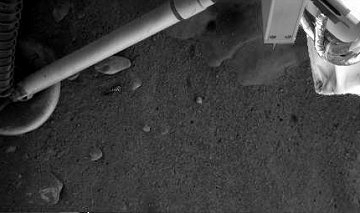
This
contrast-enhanced
image
was
taken
on
May
29th
by
Phoenix's
Robotic
Arm
Camera
(RAC).
Mission
scientists
believe
the
exhaust
from
Phoenix's
descent
engine
has
blown
off
a
layer
of
topsoil
to
reveal
a
portion
of
frozen
water
beneath.
On
the
other
hand,
it
could
be a
rock.
"We'll
test
the
two
possibilities
by
getting
more
data,
including
color
data,
from
the
robotic
arm
camera,"
says
Ray
Arvidson
of
Washington
University
in
St.
Louis,
a
co-investigator
for
Phoenix's
arm.
"If
the
hard
features
are
ice,
they
should
become
brighter
[in
the
days
ahead]
because
atmospheric
water
vapor
will
collect
as
new
frost
on
the
ice."
(Update:
Evidence
is
mounting
that
the
features
beneath
Phoenix
are
truly
ice:
more
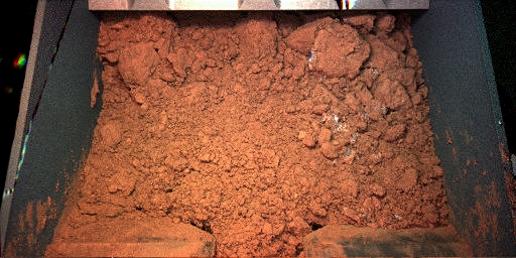
This image
from NASA's
Phoenix Mars
Lander's
Robotic Arm
Camera (RAC)
shows
material
from the
Martian
surface
captured by
the Robotic
Arm (RA)
scoop during
its first
test dig and
dump on the
seventh
Martian day
of the
mission, or
Sol 7 (June
1, 2008).
The test
sample shown
was taken
from the
digging area
informally
known as
"Knave of
Hearts."
Yesterday,
Phoenix's
7.7-foot
robotic arm
reached out
and took its
first scoop
of Mars. A
camera
attached to
the arm
snapped this
picture of
the harvest:
Scientists speculate
that the white
patches on the right
side of the image
could possibly be
ice or salts that
precipitated into
the soil. Scientists
also speculate that
this white material
is probably the same
material seen in
previous images from
under the lander in
which an upper
surface of an ice
table was observed.
The color for this
image was acquired
by illuminating the
RA scoop with a set
of red, green, and
blue light-emitting
diodes (LEDs).
The Phoenix Mission
is led by the
University of
Arizona, Tucson, on
behalf of NASA.
Project management
of the mission is by
NASA's Jet
Propulsion
Laboratory,
Pasadena, Calif.
Spacecraft
development is by
Lockheed Martin
Space Systems,
Denver.
Image credit:
NASA/JPL-Caltech/University
of Arizona/Max
Planck Institute
Note the
bright white
material
highlighting
the red
crumbly
soil. "We
don't know
what this
material is
yet," says
University
of Arizona's
Pat Woida, a
senior
engineer on
the Phoenix
team. It
could be
"ice, a salt
or something
new."
This
first scoop
was just a
test, a
light
workout for
the newly
extended
arm, and the
contents
were dumped
back onto
the ground.
Soon,
however,
similar
samples will
be drawn
inside the
lander for
analysis by
microscopes,
electrical
and thermal
probes, a
mass
spectrometer
and a wet
chemistry
lab. The
mystery
material may
yet be
known. Stay
tuned for
updates.
3D BONUS:
Like a human
being,
Phoenix's
stereo
camera has a
right and
left eye for
seeing
things in
three
dimensions.
Using images
from the two
points of
view,
graphic
artist
Patrick
Vantuyne of
Belgium has
created some
superb
anaglyphs of
the lander's
surroundings.
Put on your
3D glasses
and behold:
Mars Yeti
(Phoenix's
arm makes a
first
impression
on the Red
Planet);
One small
step...
(one of the
lander's
three feet);
Vines
(the
camera's
mast casts a
criss-crossed
shadow on
the ground).
June 5, 2008
Lander
returns
close-up
pictures of
Martian dust
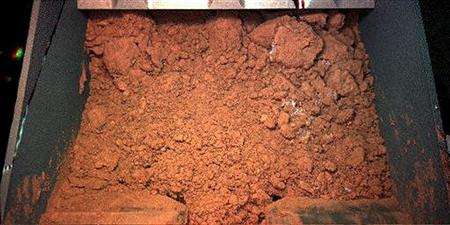
Lander
returns
close-up
pictures
of
Martian
dust
This
image
from
NASA's
Phoenix
Mars
Lander's
Robotic
Arm
Camera
(RAC)
shows
material
from
the
Martian
surface
captured
by the
Robotic
Arm
(RA)
scoop
during
its
first
test
dig
and
dump
on the
seventh
Martian
day of
the
mission
June
1,
2008
and
released
by
NASA
June
2.
REUTERS/NASA/JPL-Caltech/University
of
Arizona/Texas
A&M
University/Handout
By Dan
Whitcomb
LOS
ANGELES
(Reuters)
- The
Phoenix
lander
has
returned
the
highest-resolution
pictures
ever
taken
of
dust
and
sand
on the
surface
of
another
planet
as it
prepares
for
its
primary
mission
of
searching
for
signs
of
life
on
Mars,
NASA
scientists
said
on
Thursday.
The
pictures
were
taken
through
an
optical
microscope
and
showed
particles
--
some
as
small
as
one-tenth
the
diameter
of a
human
hair
--
that
were
collected
on a
slide
when
Phoenix
touched
down
on May
25 at
the
arctic
circle
of the
Red
Planet,
kicking
up
dust
from
the
surface.
"We
have
images
showing
the
diversity
of
mineralogy
on
Mars
at a
scale
that
is
unprecedented
in
planetary
exploration,"
Michael
Hecht
of the
U.S.
space
agency's
Jet
Propulsion
Laboratory
said
at a
media
briefing.
One of
the
tiny
grains
shown
in the
pictures,
taken
largely
to
test
the
lander's
instruments,
was
clear
and
whitish
but
the
scientists
said
it was
a
mineral
--
possibly
salt
-- and
not
likely
ice,
which
they
are
eager
to
find
as it
is
considered
key to
enabling
life
on the
planet.
Other
particles
were
reddish
brown
like
the
Mars
surface
or
dark
and
glossy.
"What
we're
seeing
in the
microscope
is
almost
certainly
not
ice,"
said
Tom
Pike,
Phoenix
geology
team
leader
and a
professor
at
Imperial
College
London,
because
a
particle
of ice
that
small
would
have
melted
before
it
could
be
photographed.
He
said
salt
deposits,
which
are
often
found
around
ice,
also
would
be
intriguing
to the
Phoenix
team.
Pike
said
the
microscopic
photos
were
never
intended
to
seek
out
ice or
other
signs
of
water
and
life
on
Mars,
and
that
the
primary
tool
for
that
is a
robotic
arm.
The
lander
was
again
given
commands
to
collect
its
first
soil
sample
from
the
Martian
surface
after
a
communication
glitch
with
an
orbiting
spacecraft
delayed
that
experiment
for a
day.
Initial
tests
by the
robotic
arm
scoop
have
uncovered
a
layer
1.5
inches
deep
near
the
landing
site
that
intrigues
NASA
officials
and
they
hope
to
study
samples
from
that
spot.
Phoenix's
robotic
camera
has
also
sent
back
images
of
what
appears
to be
exposed
ice
under
the
lander.
But
that
area
--
dubbed
"Snow
Queen"
--
cannot
be
analyzed
because
it is
out of
the
reach
of the
scoop.
The
$420-million
craft
touched
down
on the
arctic
circle
of
Mars
after
a
10-month,
420-million-mile
(680-million-km)
journey
from
Earth.
NASA
has
searched
Mars
for
the
past
decade
for
signs
of
water
and
conditions
that
might
have
supported
life.
It has
used a
fleet
of
orbiters
and a
pair
of
rovers
on the
planet.
The
detection
of
subsurface
water
on
Mars
in
2002
by the
Odyssey
spacecraft
prompted
the
Phoenix
mission.
(Editing
by
Vicki
Allen)
PHOENIX
UPDATE:
Phoenix's
oven
is
full
of
martian
soil.
For
days,
the
clumpy
red
dirt
had
been
stuck
on a
screen
at the
oven's
door
while
engineers
tried
a
variety
of
tricks
to
coax
it
onward.
On
June
10th,
with
little
warning,
the
soil
sifted
through.
"There's
something
very
unusual
about
this
soil,"
says
Peter
Smith
of the
University
of
Arizona.
"We're
interested
in
learning
what
sort
of
chemical
and
mineral
activity
has
caused
the
particles
to
clump
together."
In the
days
ahead,
Phoenix's
mass
spectrometer
will
"sniff"
fumes
from
the
oven
and
report
the
soil's
composition.
Stay
tuned.

It
is
Phoenix's
backshell,
which
held
the
parachute
as
Phoenix
descended
through
the
atmosphere.
Just
before
jet-assisted
touchdown,
the
backshell
and 'chute
were
discarded
and
they
landed
some
300
meters
downrange
of
Phoenix.
"The
parachute
is not
visible,
probably
because
of the
bumpy
terrain,"
says
graphic
artist
Patruck
Vantuyne
who
created
the
anaglyph
by
combining
right-
and
left-eye
images
from
Phoenix's
stereo
camera.
The
complete
panorama
is a
must-see;
stare
a
while
for
full
effect.
more
anaglyphs:
Arctic
Vista,
Mars
Yeti,
One
small
step...,
Vines,
Scoop
Two.

6-15-08
NASA's 420-million-dollar lander has also possibly located ice and is half way to offering scientists on Earth a 360-degree view from its landing site in the Martian polar region, with rocks and hills fading into the dusty distance.
"We're getting about twice the data volume we were told to expect," said Peter Smith, Phoenix principal investigator at the University of Arizona.
The team is hoping to find evidence of the existence of water and life-supporting organic minerals in the polar region, on the basis that the similar areas on Earth preserve traces of climate change and signs of life.
For the past week, Phoenix's robotic arm, which looks like a back-hoe, has been digging into the soil around it and uncovered a bright surface about 2-2.5 inches (5-6 centimeters) below the soil that could be ice.
"Not everybody's sure that this is ice. There's been some debate within our team," said Smith. "The debate centers around perhaps there's a salt layer above the ice, which would be very bright and white also."
The team was pretty sure they would find ice, but not whether they had already found it, he explained during a televised briefing in Tuscon, Arizona, adding that scraping further into the surface was "really a high priority."
Some of the soil collected so far was be "very clumpy, its very sticky," Smith said, and initially got stuck on one of Phoenix's oven-like instruments, the Thermal and Evolved-Gas Analyzer (TEGA). Tests are now underway.
Other finer particles meanwhile have been collected in another testing instrument and reveal the history of soil on Mars, going from black glassy particles to more weathered ones, Phoenix team member Tom Pike said.
"What we're looking at here is a potted history of Martian soil," he said.
He described "black glassy particles that over millions, even billions of years have been slowly weathering down, becoming iron-enriched which gives the organic material its characteristic (red) color, and we're seeing that process captured on the variety of particles that we're looking at."
6-21-08-
This
hard
bright
material
is
really
water
ice
and
not
some
other
substance,"
said
Phoenix
Principal
Investigator
Peter
Smith
of the
University
of
Arizona,
Tucson,
during
a
Friday
news
briefing
to
announce
the
confirmation
of
water
ice.
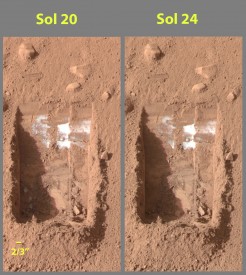
"The truth we're looking for is not just looking at ice. It is in finding out the minerals, chemicals and hopefully the organic materials associated with these discoveries," said Smith
The mission has the right instruments for analyzing soil and ice to determine whether the local environment just below the surface of far-northern Mars has ever been favorable for microbial life. Key factors are whether the water ever becomes available as a liquid and whether organic compounds are present that could provide chemical building blocks and energy for life. Phoenix landed on May 25 for a Mars surface mission planned to last for three months.
"These latest developments are a major accomplishment and validation of the Mars Program's 'follow-the-water' exploration framework," said Doug McCuistion at NASA Headquarters, Washington, director of the space agency's Mars Program. "This specific discovery is the result of an outstanding team working with a robust spacecraft that has allowed them to work ahead of their original science schedule."
The key new evidence is that chunks of bright material exposed by digging on June 15 and still present on June 16 had vaporized by June 19. "This tells us we've got water ice within reach of the arm, which means we can continue this investigation with the tools we brought with us," said Mark Lemmon of Texas A&M University, College Station, lead scientist for Phoenix's Surface Stereo Imager camera.
On the Net:
Phoenix Mars:
http://phoenix.lpl.arizona.edu
NASA Scientists
Confirm Mars Has
Water
For the last
ten years these
files have
claimed there is
water and life
on Mars.
Nasa
scientists have
revealed that
the Phoenix Mars
Lander has sent
back the first
definitive proof
that there is
water ice hidden
beneath the
surface of the
planet.
NASA
reports twenty
days of
scratching its
way through the
Martian top
soil, the
spacecraft
uncovered a
bright white
layer just two
inches below the
surface. Four
days after the
white layer was
first exposed to
sunlight above,
photographs
taken by the
lander's on
board camera
showed the white
surface had
disappeared.
This proves, the
scientists say,
that the white
layer was not
salt as had been
previously
thought possible
because it was
melting. "It is
with great pride
and a lot of joy
that I announce
that we have
found proof that
this hard bright
material is
really water ice
and not some
other
substance," said
Peter Smith,
from the
University of
Arizona, who is
the principal
investigator on
the Phoenix
mission. "We
have found the
proof that we've
been seeking."
Chemical
analysis of soil
containing the
white layer are
still to be
completed, but
there is no
doubt in the
minds of Nasa
scientists that
they will
further confirm
the presence of
water. Water
generally means
there is life as
discovered by
the Viking
Lander in 1976
1. The
36
landscape
photos
from SOL
13 for
June 8,
2008 are
all
relatively
low-pixel-count
photos -
all of
which seem
to be
slightly
out-of-focus,
and those
which I
have
downloaded
have all
been
available
in JPEG
only -
which lend
themselves
to only a
small
degree of
enlargement
at which
point
"pixilation"
effects
take over
and render
the scene
useless
for any
kind of
meaningful
study.
Further,
are only
black-and-white
images
available
from the
lander, or
are there
color
photos
available
elsewhere?
2. Most
of the
photos
posted to
the NASA
web site
for the
1976
Viking
missions
are of
strikingly
good
quality,
and are
available
in both
TIFF and
GIFF
formats,
and all
seem to
have been
focused
very well.
Sections
of most of
those
photos can
be
enlarged
as much as
10X and
still show
fine
detail of
the items
of
interest
with no
pixilation
effects at
any level
of
magnification.
And many
of the
photographs
taken by
the
landers -
and all
the photos
taken by
the
orbiters -
are in
good color
(albeit
modified
before
release to
make most
everything
have a
rust-brown
color to
it (even
the sky).
3.
QUESTION:
How does
it happen
that -
after 32
years of
improvement
in every
aspect of
imaging
techniques
and
associated
electronics
- the
photos of
Mars from
the
Phoenix
Mission
made
available
to the
public are
of such
lesser
quality
and
usefulness?
Are better
quality
photos to
be made
available
as the
Phoenix
mission
develops?
Your
assistance
in this
area of
inquiry is
appreciated.
Thanks to
John E.
Combest
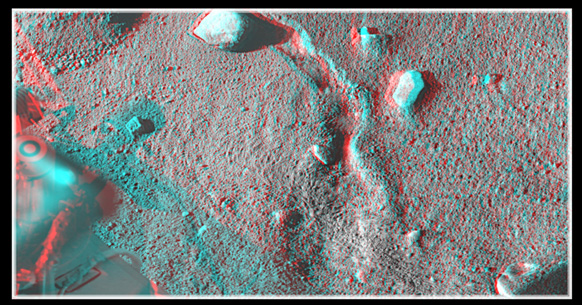
Graphic
artist
Patrick
Vantunye
of
Belgium
created
the 3D
anaglyph
by
combining
right-
and
left-eye
images
from
Phoenix's
stereo
camera.
It shows
a rock
near the
Mars
lander's
feet
seemingly
pushed
some
distance
through
the
dusty
soil.
"It
reminds
me of
the
moving
rocks of
Racetrack
Playa
in Death
Valley,"
says
Vantuyne.
Long
held to
be a
mystery,
those
Death
Valley
rocks
are
now
thought
to
travel
by means
of wind
propulsion,
skidding
along a
desert
floor
momentarily
slick
after
rainstorms.
What
moved
this
Mars
rock?
Possibilities
include
Phoenix's
landing
thrusters,
martian
wind, a
nudge
from
Phoenix's
robotic
arm, and
of
course
the
unknown.
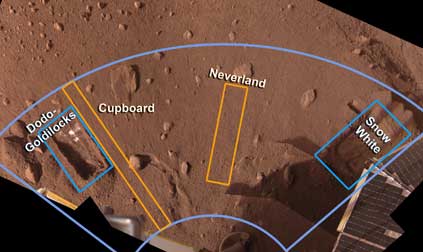
NASA's
Phoenix
Mars
Lander
Surface
Stereo
Imager
shows
four
trenches
dug by
robotic
arm
where
definite
H2O ice
has been
discovered.
Image
courtesy
NASA.
August 1, 2008 - Phoenix Lander “Tastes Water” On Mars.
First confirmation of H2O water ice.
Where there is water, there might be life, if even microbial.
“We have water. We've seen evidence for this water ice before
in observations by the Mars Odyssey orbiter and in disappearing chunks
observed by Phoenix last month, but this is the first time Martian water
has been touched and tasted.” - William Boynton, Ph.D.,
Univ. of Arizona and TEGA Lead Scientist
NASA: “Laboratory tests aboard NASA's Phoenix Mars Lander have identified water in a soil sample. The lander's robotic arm delivered the sample Wednesday, July 30, 2008, to an instrument that identifies vapors produced by the heating of samples. With enticing results so far and the spacecraft in good shape, NASA also announced operational funding for the mission will extend through September 30. The original prime mission of three months ends in late August. The mission extension adds five weeks to the 90 days of the prime mission.”
MARS LINKS & PHOTOS
MARS DATABASE
DREAMS OF THE GREAT EARTHCHANGES -
MAIN INDEX



















